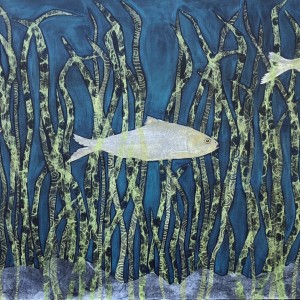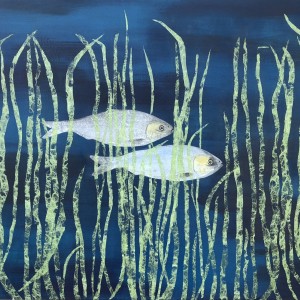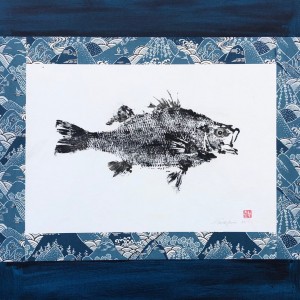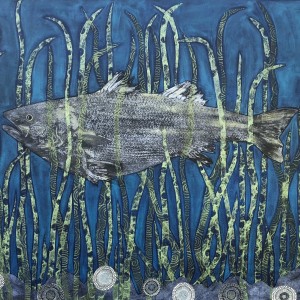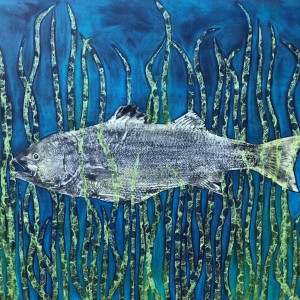Rachel Reeve
Artist Statement
Gyotaku (Japanese 魚拓, from gyo "fish" + taku "rubbing") originating from Japan is the traditional method of printing fish, a practice which dates back to the mid-1800s. It was commonly used to record and commemorate a fisherman’s catch; the impression would be a keepsake for family and friends. Once the print was complete, the non-toxic ink was washed off and the fish was cleaned to be cooked.
The gyotaku series represents a natural progression in my experimentation with the printmaking process and nature printing specifically. Having printed over the years through intaglio, monotype, woodcut, linocut, cyanotype and botanical printing, the gyotaku process was a method that I knew about but had not tried. A 2015 conversation with a friend about a recent catch of an American Shad brought gyotaku to my memory. I suggested we collaborate so that I could experiment with this historical practice. That Shad was the first in the series of gyotaku. I am attracted to the respect and affection for nature that exists in Japan. The experience of living in Tokyo from 1998 - 2001 and returning to visit in 2009 and 2010 continues to influence my artistic practice today.
Atlantic fisheries and the connected lifestyle are intrinsic to the identity of Atlantic Canada. On a smaller scale, yet very present in the Maritimes is the individual angler. Often, the angler has learned from a young age the skills and patience involved in angling. For many it is a tradition carried out through generations, shared with family and friends.
“While angling at the mouth of the Gaspereau River, N.S. I hooked and landed this bass (early August 2017). I practice catch and release but after 30 min of trying to revive the bass it was unsuccessful. To pay tribute to this magnificent catch I wanted to do something special so it was frozen until I determined what to do next. After talking with Rachel, she suggested trying Gyotaku, Japanese fish printing. After the fish printing process the bass was filleted and eaten.”
- Kyle Hicks (Environmental Scientist - Halifax, NS)
Broadly speaking each gyotaku is a reflection on our human connection with nature. They are a reminder that we share the planet with all living species and that as humans we have a responsibility in recognizing the value of the natural world. In looking closer there is a narrative, that of the angler whose own life, patience and connection with the fish is intrinsic in the evolution of this creative process. And finally there is the narrative of the fish itself, where it spawned, the waters it traveled, its age, what it ate... All of these aspects and much more contributed to the life of this creature. It is my intention that these works honour that life and its habitat.
Biography
Based in Nova Scotia’s Annapolis Valley, Rachel Reeve is an interdisciplinary artist with a BFA from NSCAD. She’s also an educator who has been teaching art in schools and in the community for over ten years. Nature and sustainability are common threads that connect the works of the artist be it mixed media, printmaking, design or installation.
Her nature oriented practice explores the historical connections with nature notably with her Gyotaku (fish prints) series. It is a salient topic in an age of over reliance on technologies and the man-made world. Reeve often draws on her experience of living in Japan with her use of printmaking, gyotaku and collage of Japanese papers. “I am attracted to the respect and affection for nature that exists in Japan.” With her Gyotaku series, she has collaborated with a local fisherman and scientist to work specifically with Atlantic species.
In thinking critically on the topic of sustainability the artist also works with recycled materials for mixed media works, functional designs and installations. This process has been extended to include land based projects, which continue the narrative of human relationships with nature. “I strive toward innovation and resourcefulness in my practice, being receptive to the new. Whether it consists of ideas or methods, an open mindset is a key ingredient in the creative process.” Some of the mixed media works are created intuitively and spontaneously while other works are approached methodically. “I think this way of working echoes the diversity in nature.”

